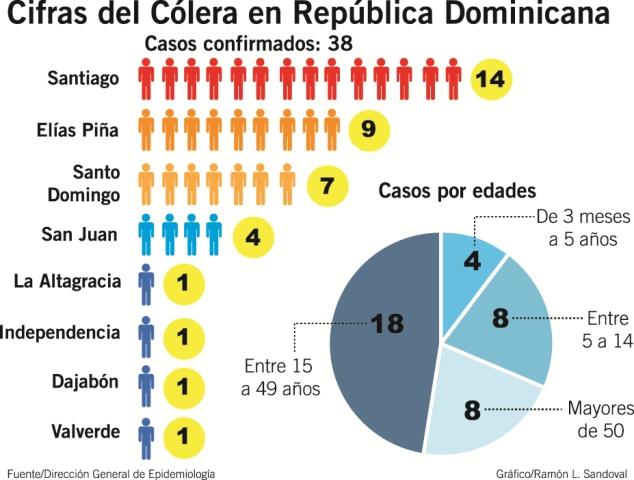Public Works worries over cholera increase in DR
A young man, 16, is case 38.

SANTO DOMINGO. The rhythm that cholera is taking in the country with an average of three confirmed cases a day has made the Health authorities increase the vigilance all over the country with the idea of avoiding a massive outbreak of the disease.
For today, the head of Public Health, Bautista Rojas Gomez, has programmed a meeting with the provincial Health directors, with the aim of informing them of the steps to be taken to face the disease that has now affected 38 persons, among them two Haitians that imported it.
The most recent case is that of a young man, 16 years old, in the community of Banica, in Elias Piña province, who was working as a farm laborer.
The idea is to treat all of the cases of diarrhea as suspicious and investigate them in laboratories to find out if they are positive or not, due to the fact that in December there is an increase in the risk of contagion because of the increase in food consumption.
The national situation with regard to cholera from 24 October when the prevention measures went into place, until yesterday is the there were 312 cases reported and 38 were confirmed, there were 11 out patients cases and 27 were hospitalized.
The provinces of Santiago, Elias Piña and Santo Domingo are the ones that are showing the greatest number of cases, with 14,9 and 7 respectively.
The Minister of Public Health explained that it is necessary to maintain the nationalization and because of this they are intensifying the campaign with a second phase that will begin next 22 December.
This effort is especially aimed at involving the families in the efforts to prevent the disease from spreading and in promoting health.
He said that they will keep watching while the threat of the disease exists, and he called upon the population to apply the recommendation that they have been issuing through the different media.
In Santiago where the greatest number of cases has been found, the authorities have prepared 35 isolation wards in the 15 hospitals in the province in order to treat patients with symptoms of the disease.
Germán guarantees the quality of the water in the aqueducts
The director of the National Institute of Potable Water (INAPA), Mariano Germán, said during the activity that it was unlikely that any citizens would contract cholera through the water from the aqueducts.
Germán said that all of the institutions that work in the handling of water are carrying out a constant monitoring of the quality, "because it is the only guarantee that in the face of a threat can respond quickly and seriously to the problem".
"At this time, the sector that deals with potable water and health is seriously committed together with the Ministry of Public Health to make sure that the water that goes through the network is quality water", said Germán as he took part in a breakfast-meeting with the water sector, organized by the Ministry of the Environment.
He said that the greatest threat to containing the disease are the superficial waters (rivers, streams and irrigation canals) and the subterranean, due to the improper that is given them.
In fact, INAPA, which manages the majority of the country's aqueducts, and the Ministry of Public Health, has determined that the Artibonito and the Banica rivers are contaminated, as well as the Hato del Yaque stream in Santiago. For that reason, citizens have been prohibited from bathing or using water from these sources.
He also asked the population to refrain from drinking water from irrigation canals because they could be contaminated.
The CAASD increases chlorine dosage
The Santo Domingo Water and Sewer Corporation (Caasd), has also reinforced the measures to keep the population from being infected with the disease through the water that it provides. Freddy Perez, the director of the Caasd, told a press conference in his office that as a preventive measure, they have increased the dosage of chlorine that is applied to the water treatment.
They are also carrying a cleanup of the water intakes. He said that the treatment plants are working but sometimes the electricity goes off.
Water sector meets in the capital
With the aim of strengthening the coordination between the governmental institutions that work with water, the Ministry of the Environment held a meeting yesterday. The first meaure taken was the creation of a Water Coordinator, which can talk about joint actions that can be taken for the preservation and rational use of this very important natural resource. Minister Jaime David Fernandez indicated that they are also trying to take an inventory of the water sources and facilitate the discussion of the laws in this sector.
For today, the head of Public Health, Bautista Rojas Gomez, has programmed a meeting with the provincial Health directors, with the aim of informing them of the steps to be taken to face the disease that has now affected 38 persons, among them two Haitians that imported it.
The most recent case is that of a young man, 16 years old, in the community of Banica, in Elias Piña province, who was working as a farm laborer.
The idea is to treat all of the cases of diarrhea as suspicious and investigate them in laboratories to find out if they are positive or not, due to the fact that in December there is an increase in the risk of contagion because of the increase in food consumption.
The national situation with regard to cholera from 24 October when the prevention measures went into place, until yesterday is the there were 312 cases reported and 38 were confirmed, there were 11 out patients cases and 27 were hospitalized.
The provinces of Santiago, Elias Piña and Santo Domingo are the ones that are showing the greatest number of cases, with 14,9 and 7 respectively.
The Minister of Public Health explained that it is necessary to maintain the nationalization and because of this they are intensifying the campaign with a second phase that will begin next 22 December.
This effort is especially aimed at involving the families in the efforts to prevent the disease from spreading and in promoting health.
He said that they will keep watching while the threat of the disease exists, and he called upon the population to apply the recommendation that they have been issuing through the different media.
In Santiago where the greatest number of cases has been found, the authorities have prepared 35 isolation wards in the 15 hospitals in the province in order to treat patients with symptoms of the disease.
Germán guarantees the quality of the water in the aqueducts
The director of the National Institute of Potable Water (INAPA), Mariano Germán, said during the activity that it was unlikely that any citizens would contract cholera through the water from the aqueducts.
Germán said that all of the institutions that work in the handling of water are carrying out a constant monitoring of the quality, "because it is the only guarantee that in the face of a threat can respond quickly and seriously to the problem".
"At this time, the sector that deals with potable water and health is seriously committed together with the Ministry of Public Health to make sure that the water that goes through the network is quality water", said Germán as he took part in a breakfast-meeting with the water sector, organized by the Ministry of the Environment.
He said that the greatest threat to containing the disease are the superficial waters (rivers, streams and irrigation canals) and the subterranean, due to the improper that is given them.
In fact, INAPA, which manages the majority of the country's aqueducts, and the Ministry of Public Health, has determined that the Artibonito and the Banica rivers are contaminated, as well as the Hato del Yaque stream in Santiago. For that reason, citizens have been prohibited from bathing or using water from these sources.
He also asked the population to refrain from drinking water from irrigation canals because they could be contaminated.
The CAASD increases chlorine dosage
The Santo Domingo Water and Sewer Corporation (Caasd), has also reinforced the measures to keep the population from being infected with the disease through the water that it provides. Freddy Perez, the director of the Caasd, told a press conference in his office that as a preventive measure, they have increased the dosage of chlorine that is applied to the water treatment.
They are also carrying a cleanup of the water intakes. He said that the treatment plants are working but sometimes the electricity goes off.
Water sector meets in the capital
With the aim of strengthening the coordination between the governmental institutions that work with water, the Ministry of the Environment held a meeting yesterday. The first meaure taken was the creation of a Water Coordinator, which can talk about joint actions that can be taken for the preservation and rational use of this very important natural resource. Minister Jaime David Fernandez indicated that they are also trying to take an inventory of the water sources and facilitate the discussion of the laws in this sector.


 Diario Libre
Diario Libre
 Diario Libre
Diario Libre